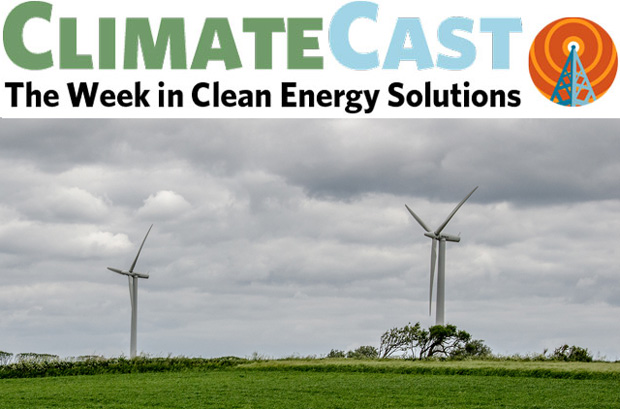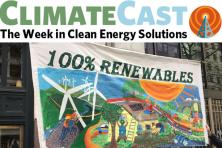Cheaper oil: a sword that cuts both ways
The dropping price of oil is a double-edged sword for the clean energy economy, according to two analyses published last week. Fewer oil exploration projects pencil out and the riskiness of fossil fuel investment becomes obvious, but petroleum-saving investments such as electric vehicles and fuel-efficient planes yield slimmer financial returns. The price collapse signals the end of OPEC as we’ve known it, but will likely affect the shale oil country of West Texas more dramatically than the Albertan tar sands. To observers as business-friendly as the Financial Times, it’s another reason to tax carbon and end petroleum subsidies, which total over $6 billion annually in the United States.
Carbon pricing advances in West and East
South Korea launched its carbon market last week, the second-largest pool of carbon emissions after the EU to be covered by a cap on climate pollution. Ontario’s environment minister said he’ll announce a carbon pricing plan this year to implement that province’s six-year-old law, and Washington’s Gov. Jay Inslee laid out the reasoning behind his proposed cap—and why he’d spend some of the proceeds on transportation. A study endorsing California’s second year of carbon trading bolstered the feasibility of these caps, but new economic research estimated that carbon emissions cost society about twenty times the current price of permits in California and the EU.
Nordic firm divests, American academia grapples
Scandinavia’s largest asset manager Nordea pulled the plug last week on coal investments, which make up less than 1 percent of its quarter-trillion-dollar portfolio. Nordea’s move puts it in the same camp as Stanford University, 300 of whose professors urged it to add oil and gas to the fossil-fuel sectors it will divest from. Meanwhile, Harvard doubled down on carbon last year, adding at least $60 million to its investments in oil and gas, despite the growing business case for divestment. Although moderates have historically offered “constructive engagement” as an alternative to divestment, that path lost credibility for a leading UK environmentalist, who renounced his efforts to work with oil majors on climate.
Economics for solar and wind adding up
Jobs in the U.S. solar industry grew by 22 percent last year, according to figures released by the Solar Foundation, bringing its well-paying jobs to more than twice the employment of coal, and close to the total for the oil and gas business. In a similar vein, a new study from Oceana says that wind turbines off the East Coast of the U.S. would generate more energy and employment than offshore oil leasing there. On- and offshore wind was key to the Danish island of Samso becoming a net electricity exporter, in a move that has attracted exchange groups from small Maine utilities hoping to replicate their success.
India makes climate moves ahead of Obama visit
Indian Prime Minister Narendra Modi reconvened his country’s climate council last week for the first time in three years, ahead of a visit from President Obama, which will include talks on clean energy cooperation that are key to India’s climate commitments. Last week, the U.S. firm SunEdison announced it will develop five gigawatts of solar power and build a $4 billion solar-panel factory in the state of Gujarat, and U.N. Secretary-General Ban-Ki Moon dedicated a solar plant there, built over a two-mile irrigation canal, a siting choice that cools the panels to increase their efficiency while also reducing water loss to evaporation.
More detail on 2014, the warmest year in history
NASA and NOAA released their analyses last week of 2014 weather data, confirming that it was the warmest year on record. The only heavily populated part of the world that experienced below-normal temperatures was the eastern United States, but its chill was out-averaged by vast tracts that were significantly warmer than average, driven in part by shifts in the jet stream and Arctic ice cover. While a single warm year could be explained by chance, the accumulation of warmer-than-average years in the last couple of decades argues that the phenomenon could not be due to random factors alone.
New data on sea level rise align better with models
Analysis published last week aligns historical tidal gauge data better with the predicted models of sea level rise. The study, which appeared in Nature, takes a new approach to estimating tide levels in areas where records were sparse during the 20th century. The new estimates reduce the rate at which oceans rose until 1990, pointing to a quicker rise since that time. Meanwhile, other researchers demonstrated a subtle consequence of Antarctic melting: the smaller the austral ice cap, the weaker the gravitational pull holding water in the Southern Ocean, allowing it to “slosh” northward and submerge coastal areas in the Northern Hemisphere.
* * *
On the Climate Solutions blog: Joelle Robinson calls for signatures urging President Obama to reject the Keystone pipeline, and Elizabeth Willmott gives an overview of climate and clean energy legislation up for debate in Olympia this session.




